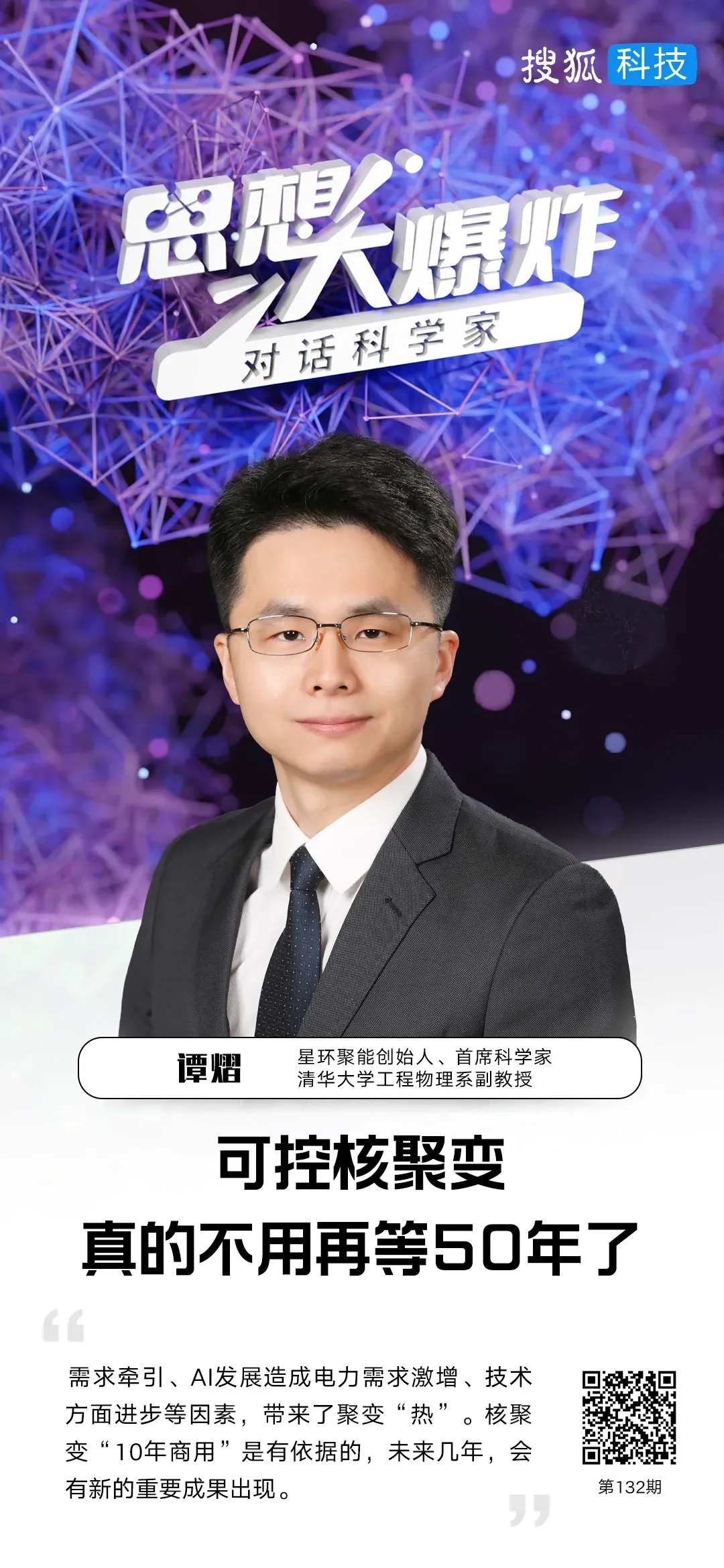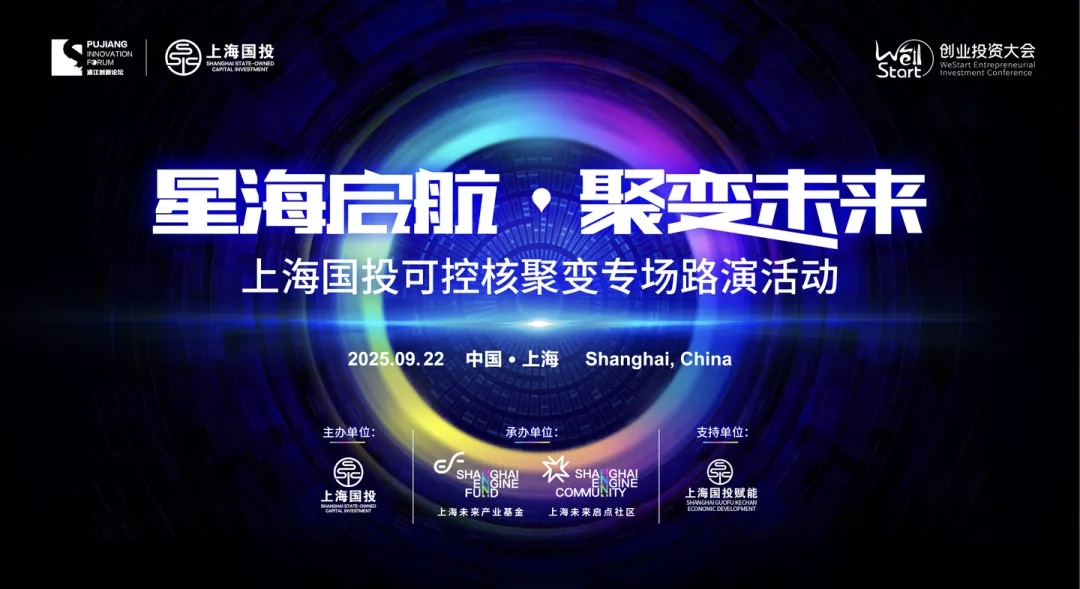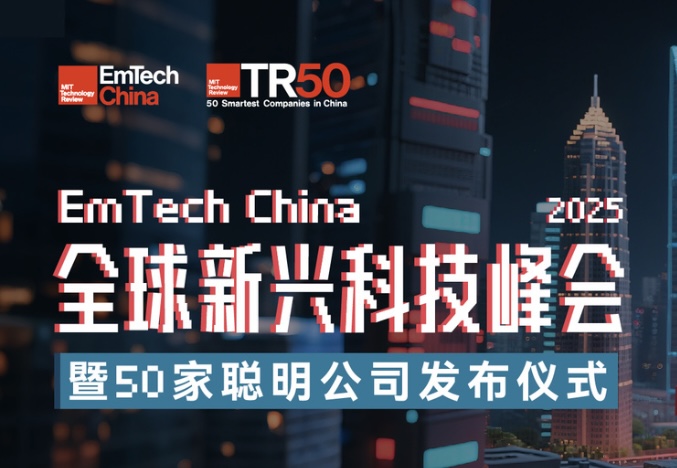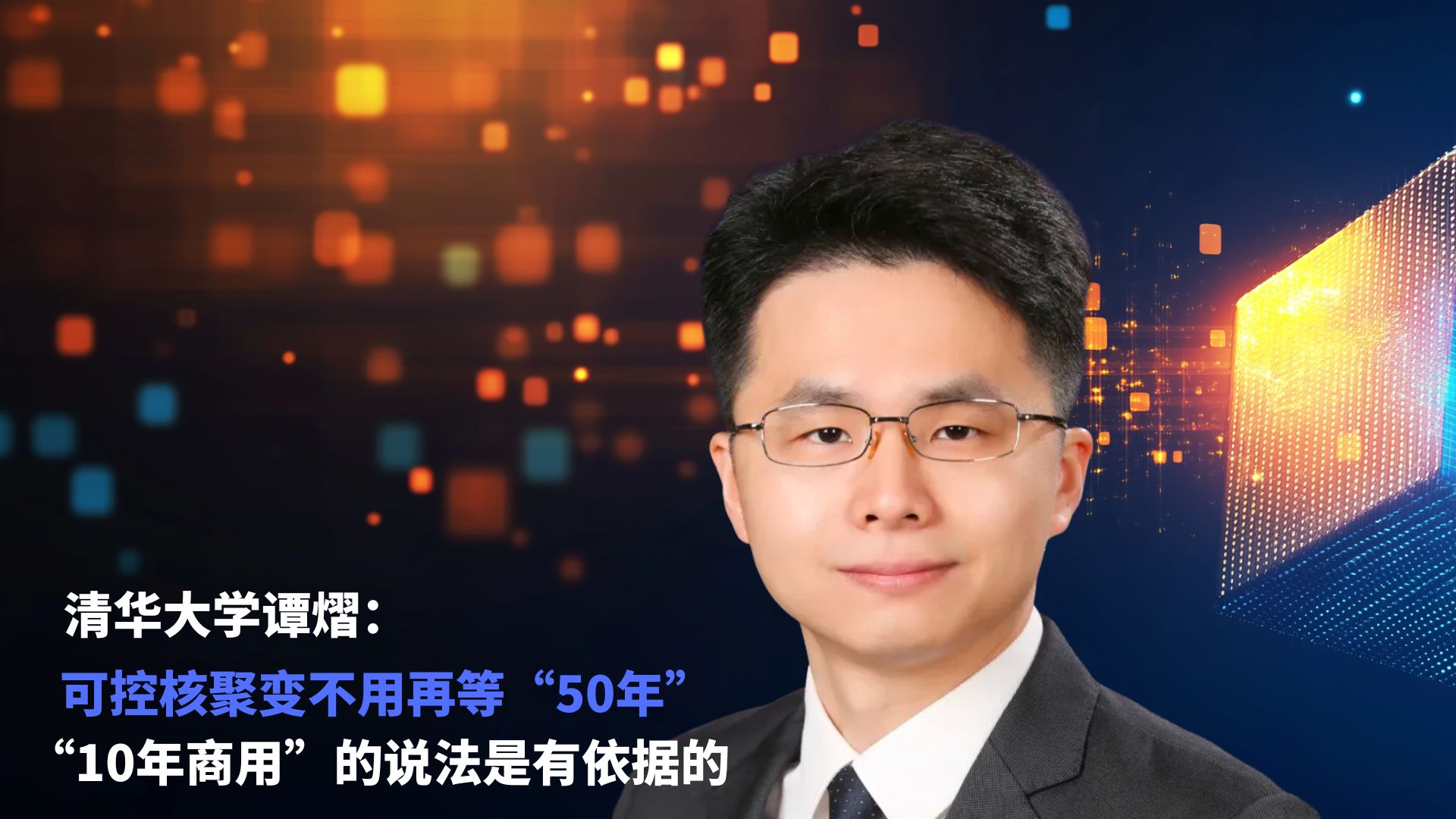
Sohu Technology Mind Explosion: Conversations with Scientists column No. 132, talks to Tan Yi, Founder, Chief Scientist and Associate Professor of the Department of Engineering Physics, Tsinghua University.
Guest Profile:
Tan Yi, Associate Professor and Doctoral Tutor of the Department of Engineering Physics, Tsinghua University, Founder and Chief Scientist of Startorus Fusion. He is mainly engaged in the experimental research and engineering technology development of magnetic confinement controlled nuclear fusion, as well as the exploration of new concept nuclear fusion mode, and is the director of SUNIST/SUNIST-2 spherical tokamak apparatus.

There is a basis for the “commercial use within 10 years” of nuclear fusion, and in the next few years, there will be important results produced by new fusion apparatus.
Factors such as demand traction, the surge in power demand caused by AI development, and technological progress have brought fusion “hot”.
If the fusion reactor is cheap enough, the cost of electricity may be less than one cent.
In the future, apparatus with higher performance will continuously be built and it will be moved towards mass production fusion power plant step by step.
Publisher|Sohu Technology
Author|Zhou Jintong
Editor|Yang Jin
Controllable nuclear fusion, which is regarded as the “ultimate dream of mankind”, is being pushed to the crossroads of hot money and commercial use.
In recent two years, the global fusion track has suddenly become “hot”. From Microsoft to Google, from Bill Gates to Sam Altman, hundreds of millions of dollars have been invested in financing. China also has Startorus Fusion, Energy Singularity, ENN Group and other enterprises that have won the favor of capital or used their own funds to carry out fusion energy research and development.
But under the upsurge, doubts never stop. “Nuclear fusion? Wait another 50 years”. This tease, which has been circulating for many years, is still the general impression inside and outside the industry.
Some people question that the influx of capital is more conceptual speculation. After all, from the laboratory to the commercial power station, there is a natural barrier from science to engineering. Others say that the so-called “commercial use within 10 years” is just an optimistic expectation of entrepreneurs, even the top scientists dare not guarantee.
In such controversy, Tan Yi led the team to complete the construction of the fusion apparatus in 279 days, and the lightning speed attracted worldwide attention.
The scientist, who has been working in the field of nuclear fusion for more than 20 years, tries to respond to the questions about “time” and “possibility” with technical details and industry insights: controllable nuclear fusion really doesn’t have to wait for “another 50” years.

Confidence in “Q value greater than 1 in 2027”
When the first time we met Tan Yi, he was carrying a black backpack and walking in a hurry. He had just arrived from Tsinghua University. After the conversation, he had to turn back and continue to work for the fusion industry to recruit new people.
“From the past performance, the efficiency of the whole team is quite high. We are confident that the Q value (energy gain) will be greater than 1 in 2027. However, the realization of fusion power generation is an extremely complex challenge after all. No one can guarantee 100% that there will be no accidents. If something goes wrong, we must find out the reasons and lay out the solutions, which is acceptable to everyone.”
This is not Tan Yi looking for a way out for himself, nuclear fusion is the exploration of “from 0 to 1”, no one can guarantee.
“Our current investors are also mature venture capital, and they are aware of this uncertainty, even if they fail to meet expectations, they will respect scientific laws.”
During the period of Tsinghua University, the prototype of the technology route of the Startorus Fusion was supported by the National Natural Science Foundation of China for directly attacking the core pain points of tokamak apparatus and the key issues of future power generation. After that, commercial venture capitalists such as Shunwei Capital and Kunlun Venture Capital, as well as government-backed funds such as CASSTAR, also entered one after another.
The first apparatus under construction, Startorus Fusion NO. 1, is expected to achieve a Q value greater than 1. Although the total investment of 1.2 billion yuan for such an apparatus, which has fusion significance and can thoroughly verify the feasibility of the project, is far lower than the traditional tokamak’s scale of tens of billions and hundreds of billions, it is not so easy to convince investors because of its long research cycle and high uncertainty.
“When I told people that it was expected to be connected to the grid in the 2030s, they were shocked and asked me: You don’t need another 50 years, how can 10 years be enough?”
Tan Yi feels that the current stage of fusion research, from funding to working status, is totally different from that before 2020. He believes that this wave of large influx of funds around 2020 will gradually become an experimental apparatus.
“We will see a lot of results in 2027 or 2028, and then you will realize that what I said ‘about 10 years’ is really well-founded.”
“What we are doing now is how to achieve fusion energy quickly and economically”. More specifically, it includes understanding the behavior of plasma, achieving better control and heating, making more powerful magnets and power supplies, developing advanced detection methods, building efficient operating systems, and using AI to rapidly improve performance”, Tan Yi said so.

Three Major Factors Promotes Global Fusion
The core team of Startorus Fusion is mostly from the Department of Engineering Physics, Tsinghua University. Whenever talking about the team, Tan Yi was very gratified, “at that time, in the laboratory of Tsinghua University, there were many exotic ideas, such as the bold use of a coil gun that no one had ever used to drive the probe to the world’s fastest speed, or the use of a curved glass tube to achieve incredible millimeter wave transmission”.
Although the triangle spherical tokamak has many advantages, there are also many troubles in engineering. Many accidents that have occurred before are concentrated in the narrowest area in the middle. Therefore, Tan Yi and his team innovatively proposed the scheme of combining the negative triangle plasma with the spherical tokamak. It was found that the negative triangle can greatly alleviate many troubles of the spherical tokamak. In addition, some foreign experiments have confirmed that the negative triangle can even more than double the density of the positive triangle, so this design is very attractive.
So, without reference standards, the team adopted this “subversive” approach, and the NTST apparatus to be built is expected to become the world’s first native negative triangle spherical tokamak.
Compared with the “The Pillars of a Great Power” of the Experimental Advanced Superconducting Tokamak (EAST), the apparatus of Startorus Fusion is more like an innovative sandbox of “trial-and-error future with minimum cost”.
“As a large national scientific apparatus, EAST is contributing to the nuclear fusion of the whole human race. We hope to innovate the basis of tokamak operation and solve the painful problems of high price, complex structure, low efficiency and high internal power consumption”, Tan Yi said so.
In Tan Yi’s view, the national team and they have different technical routes, management methods and sources of funds, which have a good complementary effect.
The national team is more like “big investment, low risk”, and they are “small investment, high risk”, but if there is no national team to lay the foundation, they can not innovate, Tan Yi thanked the national team from the bottom of his heart.
In addition to the national team, many new companies have also entered the game. In recent years, whether in China or Silicon Valley, a large number of funds and talents have poured in.
According to Tan Yi’s analysis, three factors drive the fusion industry to heat up.
“First is the demand traction. Climate change makes us have to seek ways other than fossil fuels, but existing nuclear power plants are limited by conditions, unable to meet the electricity demand contributed by fossil fuels, which now account for 60%, but fusion can fill this gap.”
Secondly, the development of AI has led to a surge in electricity demand. In addition, technological advances have made fusion reactors cheaper and shorter, attracting more venture capital.
“The influx of new companies is a good thing.” In Tan Yi’s view, although the technical routes of new players are “varied”, one more attempt will make it possible for human beings to achieve fusion energy. More importantly, industry competition has pushed up the treatment of talents. Now, the salary of a PhD in fusion is also very attractive.

“If the fusion reactor is cheap enough, the cost of electricity may be less than one cent.”
Tan Yi and his team calculate the cost of excessive electricity. The difference between fusion power plants and coal-fired power plants is that the fuel cost is almost zero. “If the fusion reactor is built cheaply enough, the cost of electricity may be less than one cent”.
But he also admitted that it is still very difficult to achieve this goal at this stage. According to the traditional large tokamak route, a million kilowatt power station may cost hundreds of billions of yuan, including 5% interest, the cost of electricity can not be reduced, “at least more than 1 yuan.”
The idea of breaking the situation of Startorus Fusion is hidden in the technical details. Based on the high temperature superconducting strong magnetic field spherical tokamak with high confinement performance, they use magnetic reconnection to heat the plasma efficiently to fusion reaction, and operate in a multi-stroke manner similar to the internal combustion engine.
This “multi-stroke cycle” runs intermittently like an engine, but there are voices questioning that “pulse operation is not practical”.
Tan Yi has a different understanding of this: “Tokamak is naturally a pulse working apparatus. If it is forced to work steadily for a long time, it will not only need to install a large number of current drive systems, but also consume electric power continuously. The overall cost is huge”.
From the economic point of view of fusion power generation, this “economic account” is also worthwhile. But it also brought other problems to Tan Yi and his team, such as periodic thermal stress and electromagnetic stress. Fortunately, they found a solution.
“Pulse work can be combined with energy storage or alternate operation of two reactors, which can continuously output energy, just like the car engine is also pulse work, the vehicle can still move forward smoothly”, he added.
At present, high temperature superconductivity and AI are also accelerating fusion research. A large part of their team’s current focus is on turning high-temperature superconducting tapes into magnets on a fusion apparatus, and AI’s research methods are naturally similar to fusion or plasma physics, which can solve complex control and measurement problems.
The plasma in the magnetic confinement apparatus is too complex, the charge of electrons and ions is the same, but the mass difference is 1800 times, the law of motion is quite different, there are translation, rotation, non-thermal equilibrium, cross-space-time scale and other issues. The equations of physics are simple, but almost impossible to solve.
Tan Yi said that people who do fusion have long been looking for rules through data-driven, and AI has made the process more than twice as fast.
The road map for the future is also clear: Startorus Fusion NO. 1 will achieve the goal of Q value greater than 1; Startorus Fusion NO. 2 will be equipped with power generation facilities and have demonstration power generation capacity; and after that, it will be a mature mass production power station.
“Although we have known that nuclear fusion is very powerful early, we have not set up a great dream of devoting ourselves to nuclear fusion since childhood.” When Tan Yi applied for a doctorate in Tsinghua University, he happened to meet the fusion laboratory of the Department of Engineering Physics, which began to recruit students. In addition, he learned that the major of nuclear fusion covered machinery, electricity, electronics, programming and other work he liked very much, so he enter the profession by accident. Over the past 20 years, this chance has already become an obsession.
Tan Yi’s choice is a microcosm of the fusion field, from the “bald associate professor” in the traditional academic circle (he laughed at himself that “there are not many papers and no hats”) to the pathfinder of the transformation of scientific and technological achievements, he brings the “ultimate dream” into reality at the speed of “279 days”.
Original link:https://mp.weixin.qq.com/s/u2dFI2TuV0Z26gPYObALZA?scene=25#wechat_redirect





